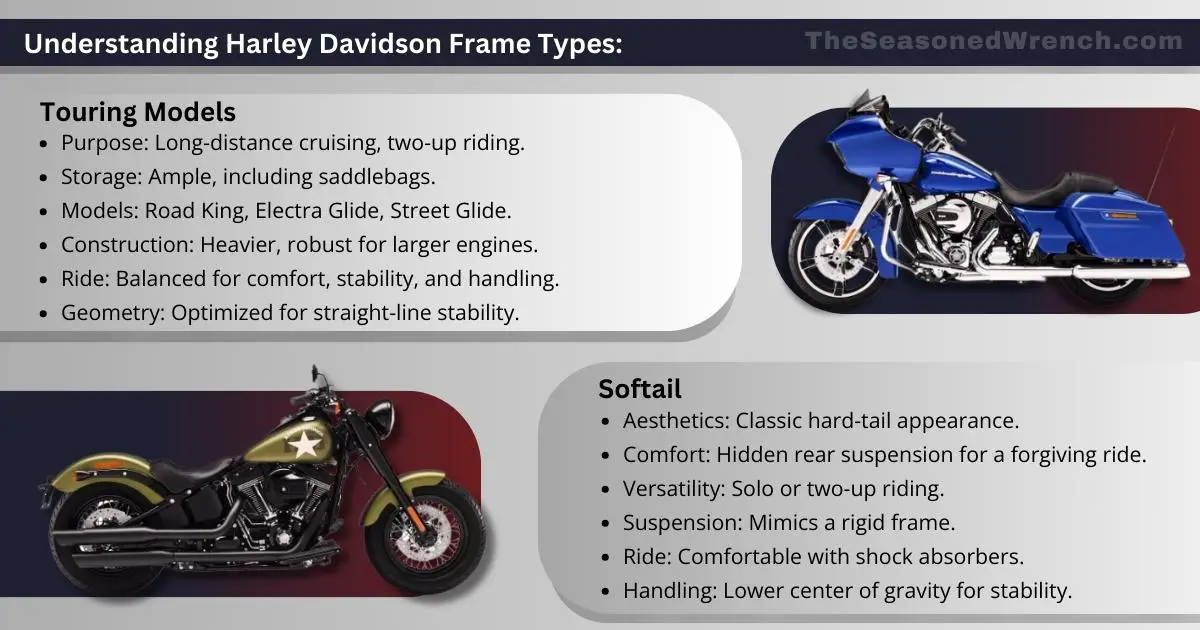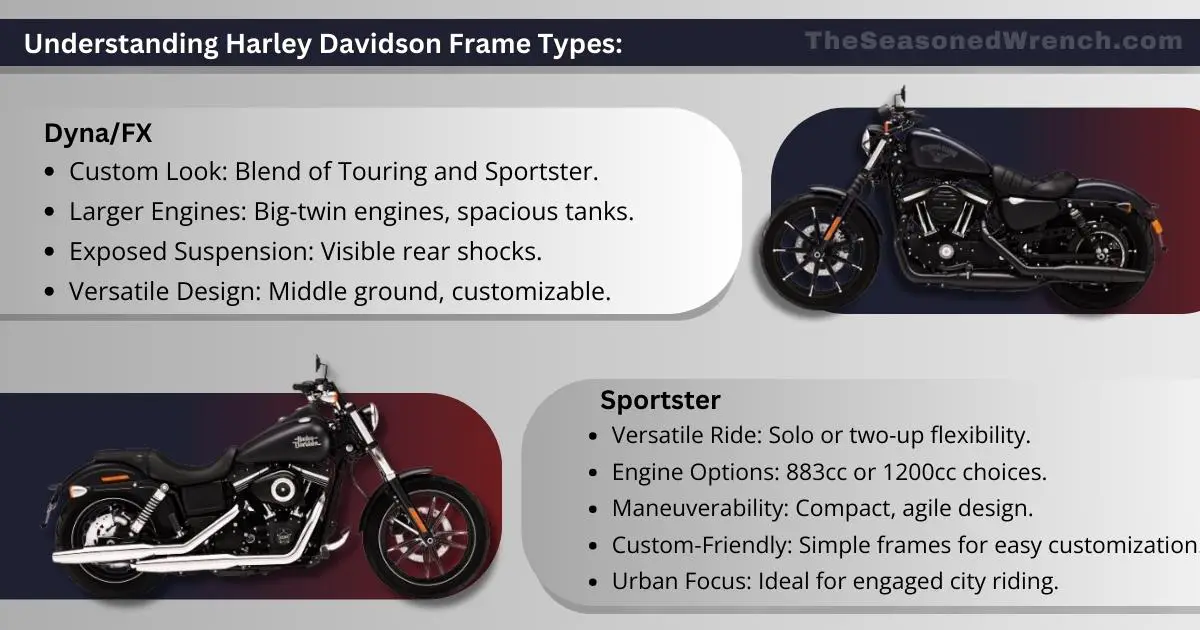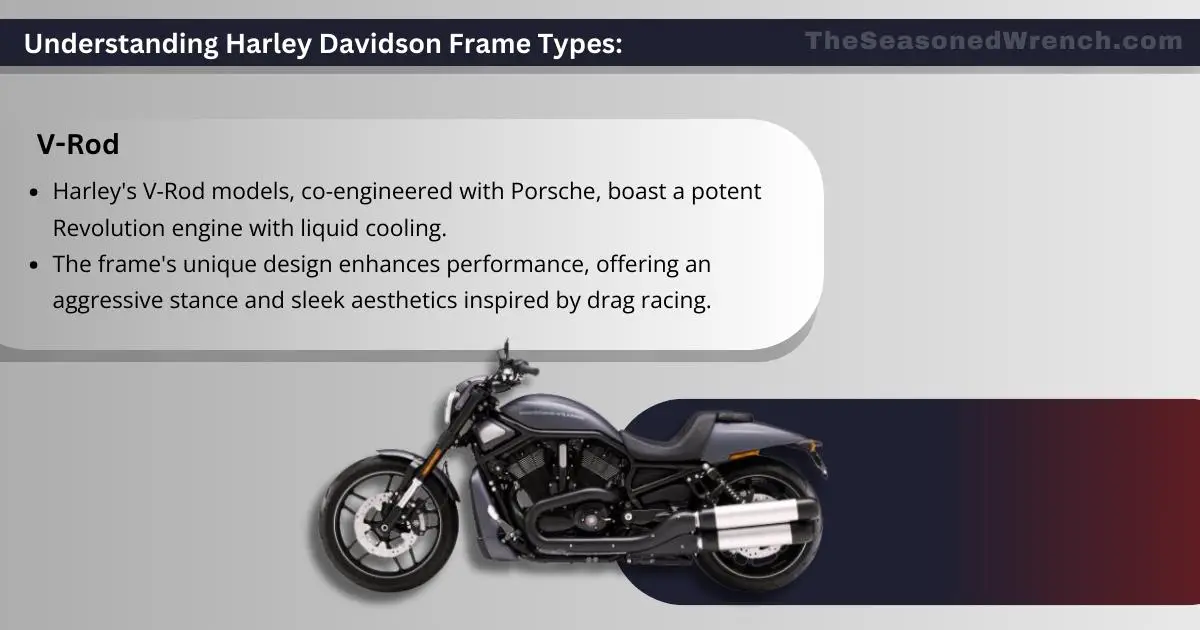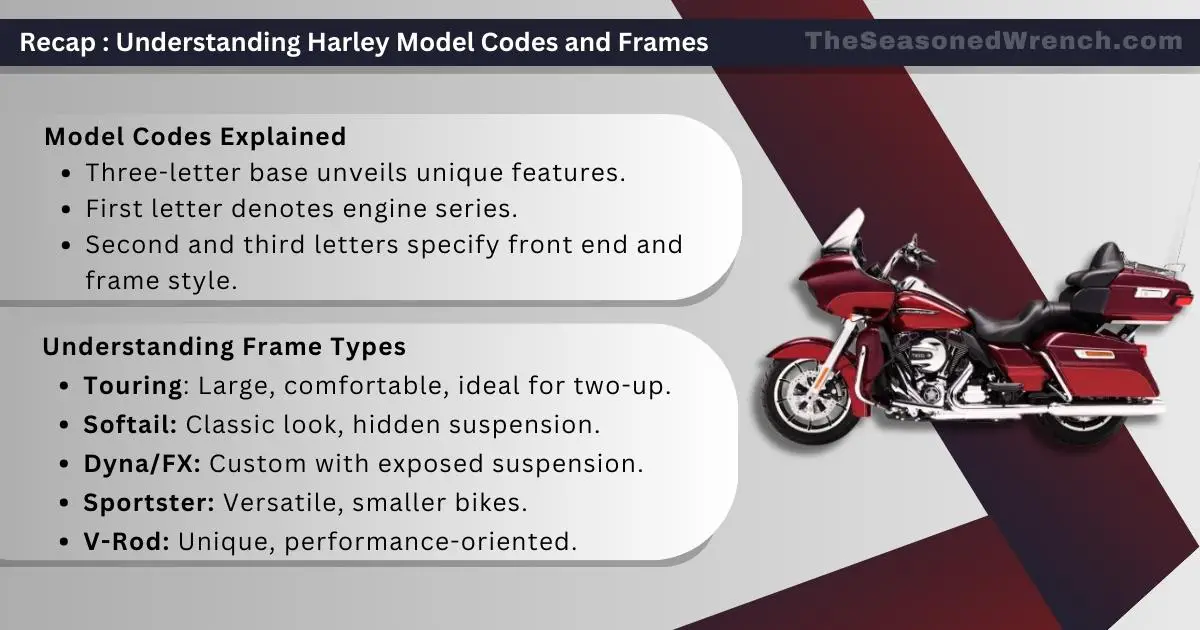Harley Davidson motorcycles are more than just a brand; they’re a symbol of freedom and a testament to American craftsmanship. Each model, from the road-trip-ready Touring to the sleek V-Rod, has its own unique appeal.
This guide aims to simplify the complexities of Harley Davidson frame types and model codes. It’s tailored to help both seasoned enthusiasts and newcomers understand the distinct characteristics and features of models like the Touring, Softail, Dyna, and Sportster.
By breaking down the specifics of frame types and model codes, this article enhances your knowledge and appreciation of these iconic motorcycles. Let’s get started!
Quick navigation:
– I Found The Best Harley For Tall Riders (No, Really)
– Does Harley Davidson Make Automatic Motorcycles? Yes And No
– Female Model Harley Davidson? Yes There Is One (or Two)
– The Search for The Best Harley For Big Guys: Concluded
– I Found The Best Harley-Davidson for Short Riders (Really)

Key Points
- Simplifying Harley Davidson Codes: The Guide Aims To Demystify Harley Davidson’s Complex Frame Types And Model Codes, Catering To Both Motorcycle Enthusiasts And Newcomers.
- Model Specifics: It Details The Unique Characteristics Of Various Harley Models Including Touring, Softail, Dyna, Sportster, And V-Rod, Highlighting Their Distinct Features.
- Code Decoding: The Article Breaks Down The Meaning Behind Harley’s Model Nomenclature, Explaining How Each Letter And Number Combination Correlates To Specific Bike Attributes.
- Frame Type Insights: It Provides An In-Depth Look At The Different Frame Types Used In Harley Davidson Motorcycles, Explaining Their Design And Functionality.
Harley Davidson’s Model Codes Explained
Harley Davidson’s model codes might initially seem like a jumble of letters, but they actually convey important information about each motorcycle. These codes typically begin with a three-letter base, followed by additional letters that indicate specific features.
Here’s a simplified breakdown:
- The first letter signifies the engine series. For example, ‘F’ for the overhead valve ‘Big Twin,’ ‘E’ stands for the overhead valve 61 cubic inch “big twin,” ‘G’ for the Servicar three-wheeler, and so on.
- The second letter represents the front end size. ‘L’ means a wide front tire with Hydra-Glide style front forks, while ‘X’ indicates a narrow tire with sportier forks. Note that these codes do not apply to Sportster and V-Rod models.
- The third letter specifies the frame style. ‘ST’ for Softail Frame, ‘H/T’ stands for Highway/Touring Frame, and ‘D’ for Dyna Frame. Any additional letters in the model code may indicate specific features associated with that bike family.
To find your Harley Davidson model code and decipher it, you can typically locate a label on the motorcycle’s frame or engine case. Refer to your owner’s manual or visit Harley Davidson’s official website for a detailed guide on decoding your specific model code. Understanding this code will help you gain insights into your bike’s key characteristics and features.
Now that you have a better understanding of how to read Harley Davidson model codes, let’s review the different frame types and what makes them each unique.
Understanding Harley Davidson Frame Types
In this section, we break down the following models from Harley:
Touring Models
Starting at the top of the Harley Davidson model hierarchy is the Touring. These bikes are the largest that Harley offers, generally featuring saddlebags, larger storage capacity, and extra room for long road trips. They’re ideal for riders who regularly travel two-up (with a passenger) and need extra room. This family includes popular models like the Road King, Electra Glide, and Street Glide.
Related:
> Electra Glide vs Street Glide: Any Real Difference?
> Street Glide vs Road Glide: Who Glides The Best?
> Road King Vs Electra Glide: Can The King Glide By?
Touring frames are engineered for long-distance comfort and stability. They typically feature a heavier and more robust frame construction to support larger engines and additional weight from luggage and accessories.
The frame design emphasizes a balanced ride and good handling at highway speeds, even when fully loaded. The touring frame’s geometry is optimized for straight-line stability, a comfortable riding position, and effective load distribution, crucial for long rides.
Harley Davidson model abbreviations for the Touring:
- FLHTCU (Ultra Classic Electra Glide): ‘FL’ for the larger engine, ‘HT’ for Highway/Touring frame, and ‘CU’ for Classic Ultra.
- FLHTK (Electra Glide Ultra Limited): ‘FL’ represents the larger engine series, ‘HT’ for Highway/Touring frame, and ‘K’ for Ultra Limited.
- FLHX (Street Glide): ‘FL’ for the larger engines, ‘HX’ denoting the Street Glide model.

Softail Models
Next in line are the Softail models. Harley’s Softail lineup provides a classic hard-tail look with the benefits of a more forgiving, yet hidden suspension system. These models are an excellent choice for riders who prioritize comfort or need a bike that provides more ‘give’ over bumps in the road. The Softail line is also great for solo or two-up riding.
The Softail frame’s defining feature is its hidden rear suspension system, designed to mimic the look of a rigid (hardtail) frame typical of vintage motorcycles. This innovative design incorporates shock absorbers or springs underneath the chassis, maintaining a sleek, classic silhouette while providing a more comfortable ride than a true hardtail.
The frame is designed to be lower to the ground, offering a lower center of gravity and easier handling, especially at lower speeds or when stationary.
Related: Dyna Vs Softail: What’s The Difference?
Here are some of the Harley Davidson model codes for Softails:
- FLSTC (Heritage Softail Classic): Here, ‘FL’ represents the Big Twin engine, ‘ST’ for the Softail frame, and ‘C’ for the Classic version.
- FLSTF (Fat Boy): ‘FL’ for the larger series, ‘ST’ for Softail frame, ‘F’ for Fat Boy.
- FXSTS (Softail Springer): ‘FX’ for the sport series, ‘ST’ for Softail, ‘S’ for Springer.
Dyna/FX Models
The Dyna Model offers a custom bike look with the rear end of larger Touring models and the front end of a Sportster. The Dyna is distinguishable by its larger big-twin engines and slightly larger gas tanks. The suspension is traditionally exposed, unlike the hidden suspension on the Softail models.
Dyna Harley Davidson models are characterized by their traditional twin-shock frame. Unlike the hidden suspension of the Softail, Dyna frames have visible rear shock absorbers, which are part of the bike’s aesthetic.
The frame itself offers a middle ground between the heavier Touring and lighter Sportster frames, providing a blend of comfort and handling. This makes Dyna frames particularly versatile for customization, as they accommodate a wide range of riding styles and rider preferences.
Related: Dyna vs Sportster: Which Is Better and Where?
Dyna/FX Harley Davidson model code examples:
- FXDL (Dyna Low Rider): ‘FX’ for the Big Twin sport model, ‘D’ for Dyna frame, and ‘L’ denotes the Low Rider variant.
- FXDWG (Dyna Wide Glide): ‘FX’ for Big Twin sport, ‘D’ for Dyna frame, ‘WG’ for Wide Glide.
- FXDXT (Super Glide T-Sport): ‘FX’ for Big Twin sport, ‘DX’ for Dyna, ‘T’ for T-Sport.

Sportster Models
The Harley Sportster Models are the brand’s smaller bikes, offering great versatility for either solo or two-up riding. Sportsters are available with two motor size options – either 883cc or 1200cc. These models stand out for their adaptability to a variety of riding conditions, from city streets to open highways.
Sportster frames are known for their compact and agile design. They are lighter and smaller compared to other Harley frames, contributing to the Sportster’s reputation for maneuverability and spirited handling. The frame design emphasizes ease of riding, particularly in urban environments or for those who prefer a more engaged riding experience.
The simplicity of the Sportster frame also makes it a popular choice for custom builders. Its streamlined structure allows for easier modifications, making it a favorite among riders looking to personalize their motorcycles.
Here are some of the Harley Davidson model codes for Sportsters:
- XLH883 (Sportster Hugger): The ‘XL’ denotes the Sportster series, and ‘H883’ specifies the Hugger variant with an 883cc engine.
- XL883 (Sportster 883): ‘XL’ represents the Sportster series, and ‘883’ indicates the engine displacement in cubic centimeters.
- XL883C (Sportster 883 Custom): ‘XL’ for the Sportster series, ‘883’ for the engine displacement, and ‘C’ for the Custom version of the Sportster 883.
V-Rod Models

Perhaps the most unique model in Harley’s lineup, the V-Rod models feature a distinct engine developed jointly with Porsche. These models are power-packed with a Revolution engine that utilizes overhead cams and liquid cooling, marking a significant departure from the traditional air-cooled engines Harley is known for.
Related: Revolution Max Engine Problems, Overview, Specs and More
The V-Rod frame is distinctively different from other Harley Davidson frames, designed to house the Revolution, which is a liquid-cooled, overhead-cam powerhouse. This frame is built for performance and handling, with a more aggressive riding position and a lower center of gravity.
The hydroformed main rails in the frame contribute to its unique, sleek, and modern look, setting it apart from the classic Harley Davidson style. Additionally, the V-Rod’s frame is designed with a drag racing influence, evident in its stretched-out profile and the radiator’s integration into the front of the bike.
V-Rod Harley Davidson model code examples:
- VRSCDX (Night Rod Special): ‘VRSC’ indicates the V-Rod model, and ‘DX’ differentiates it as the Night Rod Special.
- VRSCAW (V-Rod): ‘VRSC’ denotes the V-Rod series, and ‘AW’ specifies this particular model, known for its wider rear tire (240mm) and distinctive finishes.
- VRSCF (V-Rod Muscle): ‘VRSC’ for V-Rod, ‘F’ for Muscle model.
Other Harley Davidson Models
Harley rounds out their lineup with trikes and their new Street Bike series, as they continue to expand into new markets, offering a bike or trike for just about anyone on the road.
Here are some of the Harley Davidson model codes for these other models:
- XG750 (Street XG750): ‘XG’ represents the Street series, a more recent addition to Harley’s lineup, and ‘750’ indicates the engine capacity in cubic centimeters.
- FLHTCUTG (Tri Glide Ultra Classic): In this code, ‘FL’ signifies the Big Twin engine, ‘HT’ for Highway/Touring frame, ‘CU’ denotes the Classic Ultra, and ‘TG’ represents the Tri Glide, Harley’s trike variant.
- XG500 (Street XG500): ‘XG’ designates the Street series, and ‘500’ indicates the engine capacity in cubic centimeters for this model.
Recap: Understanding Harley Model Codes and Frames

In this guide, we’ve explored the intricate world of Harley Davidson, shedding light on the various frame types and model codes that define these legendary bikes.
From the expansive Touring models to the sleek V-Rods, each Harley is a unique blend of style, performance, and history. This guide serves as a key to unlock a deeper understanding and appreciation of these motorcycles, whether you’re eyeing a new purchase or planning a custom build. Remember, every Harley tells a story, and now you’re better equipped to read these tales.
Enjoy the ride!
Read next: Does Harley Davidson Make Automatic Motorcycles? Yes And No